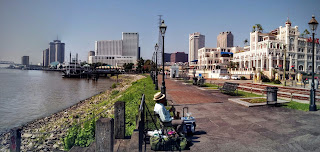Geography
If you’re anything like me, you just winced at that word. Geography is annoying, complicated and unlike other, more decent sciences such as physics, it's dickish enough to get you ridiculed if you’re not good at it. I don’t like it, is what I’m saying. Anybody who’s ever been with me on a trip to a place that’s not my hometown can attest to that. And for a long time, I’ve quite successfully dealt with this issue like any problem-oriented grown-up would and put all my effort into ignoring it until it went away.
Then came one unflattering moment in February 2013 when I discovered that I’d always misjudged the Mississippi’s flow direction. That’s almost two years after I spent an entire semester in New Orleans in 2011. Not one of my proudest moments. I vowed to remedy that by working on trying to understand New Orleans geography, should I ever get another chance (not knowing I would return to the city in 2016 and actually have to make good on that promise). Which brings us here. Now that you know what got us into this mess (damn you, Mississippi) let’s get this over with:
Maps have something to do with geography, right?
Driving north ...
... and looking back towards New Orleans.
38km of pure joy that connect New Orleans with the North Shore communities. The North Shore is home to Fountainbleau State Park, the very popular local Abita brewery and that lovely gentlemen in camouflage I introduced you to in the last post.
The lake itself spans over 1600km2, which means you could fit just about 5 Lake Neusiedls in there (it's also very shallow, only a few meters deep on average). In one of its darker moments, it was the origin of most of the water that flooded the city during Hurricane Katrina, as the storm pushed so much water into the lake that the sub-standard levees couldn’t hold the pressure and broke. The water itself is brakish, somewhat smelly and reportedly houses alligators. This might be not such a bad thing, as UNO and its student dorms are located right at the southern shore of Lake Pontchartrain and alcohol induced skinny dipping sounds like a bad idea, even without any alligators.
If we take a closer look at the city itself, it becomes quite clear that UNO is not really at the center of things. I’ve highlighted some of the cool stuff in this section and you’ll notice that there’s a vast stretch of housing that separates us from downtown New Orleans.
Details in no particular order: 1. Algiers, 2. French Quarter (with Bourbon Street),
3. this is where I play volleyball!, 4. Frenchmen Street, 5. Bywater
Who could resist that?
If Bourbon Street is your charming trans aunt with an alcohol problem that keeps stealing money from your piggy bank, then Frenchmen street is your friend's dad who tells stories about the time he was your age. Yes, he has a regular income now, but when he gets out that bass guitar, he still plays it like a damn pro. It’s so much fun to be there, but again - most locals will be on stage. I'm not entirely sure yet how to feel about this. On the one hand, this place is famous for good music, so there will always be an endless supply of fantastic musicians. That again draws insane numbers of tourists, which, of course, is the last thing you want to see, as a tourist. The whole thing is very schizophrenic. There's plenty of great music outside of Frenchmen Street too, of course (Tremé Fall Fest was great!), but at the end it's the easiest way to catch a few live bands, especially if you don't have a car. However, it does feel a little bit strange to be part of an almost entirely white audience in a town that is about 60 percent African American. Makes you feel as if your part of a hard to define problem, and that’s not a particularly good feeling.
Which kind of brings me to St Claude and the Bywater. In our analogy, that area would be your friend’s hipster cousin. It’s where much of the artsy stuff happens right now. College crowd. Often great, sometimes over the top, all of it weird.
Not quite HD, but a good example of what I'm talking about.
And so I’m sitting here on a bench overlooking the Mississippi, thinking too much about problems people way smarter than me haven’t been able to solve. “What a great use of my time here,” I ponder and melodramatically glance across the river. And do you know what’s across the rive? A neighborhood called Algiers. Algiers, which is really only reachable by ferry and therefore has very little tourism. They call it "New Orleans' best kept secret". I take the ferry and spend a pretty cool day there in the midst of weird gardens, cool cafés, friendly people and fantastic live music at a place called Old Point Bar. I know I have to catch the last ferry at ten, but that’s quite alright. It’s a small price to pay for getting away from slightly distracting musings about annoying things such as tourism, gentrification and most of all, that bastard geography.
Found it!







No comments:
Post a Comment